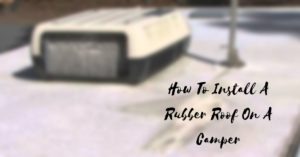Disclosure: this post may contain affiliate links. As an Amazon Associate we earn from qualifying purchases.
The roof of your RV is a very important part of your RV and needs to be protected from natural elements. You need to make sure it’s protected from harsh elements outdoors like fog, dust, sandstorms, rainstorms and so on.
A high-quality rubber roof on your RV will effectively do the job of protecting the roof. However, some people may not know how to do this properly. In order to help you out with the process of installation, we have created a step-by-step guide which you will find in this article. Follow them diligently and you will be good to go.
Contents
Tools and Materials Required For Installation
Before we move onto the process of installation, you need to have all the required tools and Materials handy so that you don’t find yourself short of them. Here is a checklist of materials you will be needing:-
- Rubber roof
- Roof adhesive
- Lap sealant
- Paint roller
- Ladder
- Screwdriver
- Putty knife
- Metal shears or saw (for removing metal roof)
- Electric sander
It is possible to sand manually but we recommend using an electric sander for faster and better results. If you don’t want to buy this tool, you can try borrowing or renting one from someone.
You will require shears only if your RV has an old metallic roof that needs to be replaced. If it already has a rubber roof, then you won’t require shears.
How to replace your RV or Motorhome roof EPDM or TPO
Follow these steps carefully to install a rubber roof on your RV:-
- Step 1
You have to remove the vents, hoods, & housings from the roof to begin the process. Vents and housings can be removed by unscrewing them with a Phillips or a 1/4″ head screwdriver. You can also use a putty knife to scrape off the old lap sealant that will help to pry the vent or housing off the roof.
- Step 2
You will also need to carefully remove any termination bars, strips or caps on the RV. Again even for this, you will require a putty knife to remove any lap sealant that covers the screws. After that, you will simply unscrew and remove these parts.
In case your termination bars or drip edges are fixed or attached using rivets, you have to use a chisel to pry open the rivet head.
- Step 3
This step is crucial for those who have to replace their old roof or install a new one. In the case of an existing rubber roof, you’ll have to scrap the rubber roof off to get rid of the old one. You can use the shears for removing an old metallic roof in case your RV has one. Remember to wear protective clothing as you will be dealing with metal scraps.
- Step 4
Just removing the roof will not do the job. You also have to clean the surface to prepare it for new roofing. In case you find that there are a lot of inconsistencies on the deck then you may have to sand it or use seam tapes to cover any unnecessary gaps in the seams. You can also replace any of the plywood roof foundations as required. Make sure the roof is not wet before applying the glue. You have to make sure the surface is even so that the roof fitting is better and stays put for a long time.
- Step 5
In this step, you might need someone else for some extra help. The ideal way to go about this is to take up parts of the roof at a time. You can begin by placing the new rubber roof roll on one end of the roof. Now try to adhere the rubber roof to the deck. It would be better if you secure it in small sections and work your way up till the other end. This will make sure the roof is sealed evenly. Next, you will use a paint roller to put the adhesive onto the roof deck and then roll the new roof membrane over the adhesive. Make sure there are no air bubbles. You can also cut off excess roofing material with a knife to make it fit properly.
- Step 6
After you have set the roofing, you will also need to make new holes for your vents, hoods, and housings that you had kept aside. You can simply use a strong utility knife to do the job. It is advisable to cut the holes in a “X” shape, that will help you fold each flap down for screwing the parts.
- Step 7
In the last step you will need to reinstall all the vents, termination bars, drip edges, strips, and caps. Make sure everything is consistent and shave off the excess materials for a clean finish. Don’t forget to make sure that the roofing has been set properly before you try to put the parts back on the deck. In case your RV had rivets to secure any of the components, you might have to move the component when you reinstall it. It is recommended you use screws to fix the parts as it will be easier to remove in the future when you replace the roof again.
These are all the steps you need to follow to install a new rubber roof on your RV. In the end, we would like to just remind you of a few things that you should remember when you install a new roof:-
- Make sure the deck is even before attempting to glue the new roof on.
- Always use screws to fix removable parts so that you can easily replace the roof when required.
- When putting on the glue and the membrane, make sure there are air bubbles; otherwise, it won’t be secured properly.
- While you can do everything on your own, you should try to get another person to help as it will make the work get completed faster.
- Make sure you maintain the roof properly and change it on time to avoid on-road disasters.
Amazon and the Amazon logo are trademarks of Amazon.com, Inc, or its affiliates.

